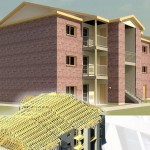 Building Information Modeling (BIM) has revolutionized the way civil engineering projects are designed, managed, and executed. As a digital representation of the physical and functional characteristics of a facility, BIM provides a shared knowledge resource that supports decision-making throughout the project lifecycle, from earliest conception to demolition. The adoption of BIM in civil engineering brings numerous benefits, enhancing efficiency, reducing costs, and improving project outcomes. Here, we explore the key advantages of incorporating BIM into civil engineering projects.
Building Information Modeling (BIM) has revolutionized the way civil engineering projects are designed, managed, and executed. As a digital representation of the physical and functional characteristics of a facility, BIM provides a shared knowledge resource that supports decision-making throughout the project lifecycle, from earliest conception to demolition. The adoption of BIM in civil engineering brings numerous benefits, enhancing efficiency, reducing costs, and improving project outcomes. Here, we explore the key advantages of incorporating BIM into civil engineering projects.
Enhanced collaboration and communication
One of the most significant benefits of BIM is its ability to foster improved collaboration and communication among project stakeholders. BIM allows architects, engineers, contractors, and clients to work on a unified model, ensuring that everyone has access to the most up-to-date project information. This collaborative environment reduces misunderstandings and miscommunications, leading to fewer errors and omissions. By providing a single source of truth, BIM facilitates seamless coordination and integration of different project aspects, ultimately contributing to a more cohesive and efficient project delivery.
Improved visualization and planning
BIM’s advanced visualization capabilities enable stakeholders to see a project in three dimensions before construction begins. This ability to visualize the project in its entirety allows for better planning and design decisions. Engineers can identify potential issues early in the design phase, reducing the likelihood of costly changes and rework during construction. Furthermore, BIM’s ability to simulate different scenarios and perform what-if analyses helps engineers optimize design solutions, ensuring that the final product meets both functional and aesthetic requirements.
Enhanced accuracy and precision
Traditional 2D drawings can sometimes lead to inaccuracies and misinterpretations, which can have significant consequences during construction. BIM, on the other hand, provides a highly accurate and detailed representation of the project, minimizing the risk of errors. The precision of BIM models ensures that all elements fit together as intended, reducing the likelihood of clashes and discrepancies during construction. This level of accuracy not only improves the quality of the final product but also enhances the overall efficiency of the construction process.
Increased efficiency and productivity
BIM streamlines the entire project workflow, leading to increased efficiency and productivity. By automating many of the routine tasks associated with design and documentation, BIM frees up engineers to focus on more complex and value-added activities. The integration of various project aspects into a single model also reduces duplication of effort and ensures that everyone is working with the same information. This streamlined approach reduces delays, accelerates project timelines, and ultimately leads to cost savings.
Better cost management and control
Cost management is a critical aspect of any civil engineering project, and BIM provides powerful tools to help manage and control costs more effectively. BIM enables detailed and accurate quantity takeoffs, which form the basis for reliable cost estimates. The ability to link the model to cost databases and perform real-time cost analysis helps engineers and project managers keep track of budgets and identify potential cost overruns early. By providing a clear picture of project costs at every stage, BIM supports better decision-making and financial control.
Enhanced sustainability and energy efficiency
Sustainability is becoming an increasingly important consideration in civil engineering, and BIM plays a crucial role in promoting sustainable practices. BIM allows engineers to assess the environmental impact of different design options and choose the most sustainable solutions. The ability to simulate energy performance and analyze building systems helps optimize energy efficiency, reducing the project’s carbon footprint. By supporting sustainable design and construction practices, BIM contributes to the creation of greener and more environmentally friendly infrastructure.
Improved facility management and maintenance
The benefits of BIM extend beyond the construction phase, providing valuable information for the operation and maintenance of the facility. The detailed and accurate as-built model created during construction serves as a comprehensive resource for facility managers. BIM provides a wealth of information on building components, systems, and maintenance schedules, making it easier to manage and maintain the facility over its lifecycle. This enhanced visibility and control over building operations lead to improved efficiency, reduced operational costs, and a longer lifespan for the infrastructure.
Building Information Modeling (BIM) is transforming the landscape of civil engineering, offering a multitude of benefits that enhance project outcomes, improve efficiency, and reduce costs. From enhanced collaboration and communication to better cost management and sustainability, BIM provides a powerful toolset for engineers and project managers. By adopting BIM, civil engineering projects can achieve higher levels of precision, productivity, and overall success.
For comprehensive design services that leverage the latest in BIM technology, look no further than McNeil Engineering. Our team of experts is committed to delivering timely, responsive, and economical design solutions across civil engineering, structural engineering, land surveying, high-definition scanning (HDS), landscape architecture, and consulting services. Whether you are in the private or public sector, we are here to help you achieve your project goals with precision and excellence.
Contact McNeil Engineering today at McNeil Engineering to learn more about how we can support your next project with our comprehensive design services.








